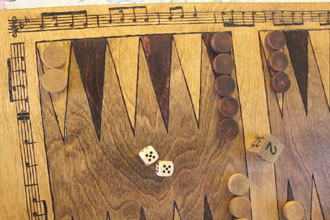|
| Magriel's NYT Columns |
 In backgammon, a player strives with each roll to improve his position. What constitutes improvement, however, often depends on the overall board position. As a result, plays that appear constructive may have little value or may actually be detrimental.
In backgammon, a player strives with each roll to improve his position. What constitutes improvement, however, often depends on the overall board position. As a result, plays that appear constructive may have little value or may actually be detrimental.
For example, a basic goal is to construct new points. Generally, each new point restricts the opponent’s movement while facilitating the safe movement of one’s own men. Because building points is such a natural objective, many players will do so automatically, without stopping to consider if they serve a useful function.
In the diagrammed position, Black has escaped with both his back men and is well ahead in the race. White is playing a holding game — that is, waiting for Black to leave a man exposed and then hoping to hit.
|
| Black to play 2-1. |
Owning the 14-point serves no useful function: it does not significantly hinder White’s movement; more important, it does not help Black achieve his main objective — to bring his men home safely. Indeed it is a liability, because it gives Black an additional point to “clear.” Furthermore, by tying up all his spare men, it leaves Black with an inflexible and dangerous position.
The correct play is 16/13, simply moving the exposed man on the 16-point all the way to the mid-point (13-point). By not making an unnecessary extra point, Black reaches a much safer position.
|
|
|
When evaluating a play, it is important to consider how the position will evolve. Failure to do so, by taking a static viewpoint, may result in a malady known as T.M.P (too many points). Holding too many points at one time can create a position that looks strong but is untenable because it lacks flexibility. To avoid T.M.P., you must examine the dynamics of a position. In particular, before making points you must consider if you can profitably hold them.
Rollout
 Tom Keith 2013 |
|
Money play Centered cube Black rolls 2-1 1296 games with VR Checker play: 2-ply Cube play: 3-ply Red |
| 2-1: | Game | G | BG | Equity | ||||
| 1 | 16/13 |
W L |
.6127 .3873 |
.0915 .0880 |
.0039 .0024 | +0.3892 |

| (b) |
| 2 | 16/14, 15/14 |
W L |
.5941 .4059 |
.0950 .1000 |
.0048 .0030 | +0.3266 | (0.0626) | (a) |

|
|

